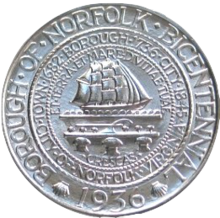United States | |
| Value | 50 cents (0.50 US dollars) |
|---|---|
| Mass | 12.5 g |
| Diameter | 30.61 mm (1.20 in) |
| Thickness | 2.15 mm (0.08 in) |
| Edge | Reeded |
| Composition |
|
| Silver | 0.36169 troy oz |
| Years of minting | 1937 (coins bear the date 1936) |
| Mintage | 25,000 with 13 pieces for the Assay Commission (8,077 melted) |
| Mint marks | None, all pieces struck at the Philadelphia Mint without mint mark |
| Obverse | |
 | |
| Design | City seal of Norfolk, Virginia |
| Designer | William Marks Simpson and Marjory Emory Simpson |
| Design date | 1937 |
| Reverse | |
 | |
| Design | Norfolk's ceremonial mace |
| Designer | William Marks Simpson and Marjory Emory Simpson |
| Design date | 1937 |
The Norfolk, Virginia, Bicentennial half dollar is a half dollar commemorative coin struck by the United States Bureau of the Mint in 1937, though it bears the date 1936. The coin commemorates the 200th anniversary of Norfolk being designated as a royal borough, and the 100th anniversary of it becoming a city. It was designed by spouses William Marks Simpson and Marjory Emory Simpson.
Virginia Senator Carter Glass sought legislation for a Norfolk half dollar, but the bill was amended in committee to provide for commemorative medals instead. Unaware of the change, Glass and the bill's sponsor in the House of Representatives, Absalom W. Robertson, shepherded the legislation through Congress. Local authorities in Norfolk did not want medals, and sought an amendment, which passed Congress in June 1937.
The legislation required that all coins be dated 1936; thus, there are five dates on the half dollar, none of which are the date of coining, 1937. By that time, the anniversaries had passed, and sales were poorer than hoped; almost a third of the mintage was returned for melting. The Norfolk half dollar is the only U.S. coin to depict the British crown, shown on the city's ceremonial mace, found on the reverse ("tails" side) of the coin.